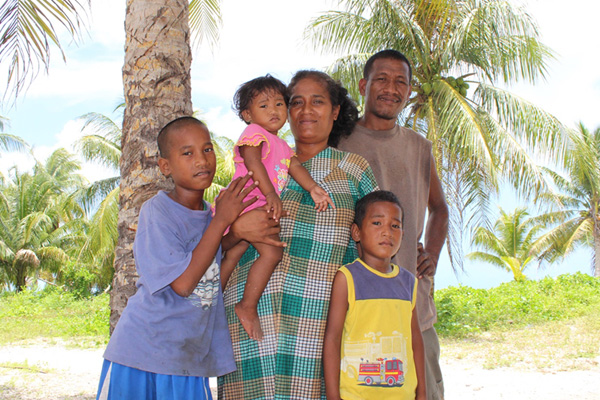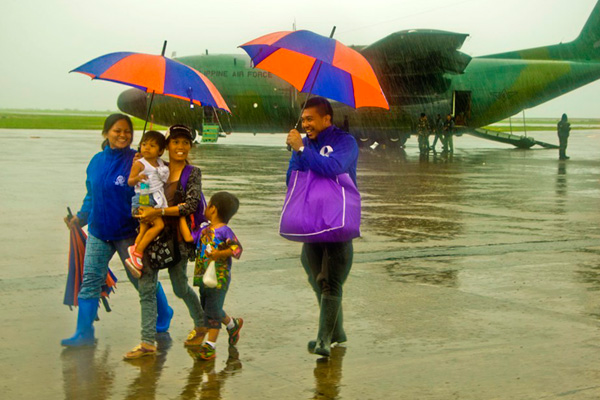
Families in the Marshall islands could soon not have an island home with fresh water and crops due to salt water inundation and persistent drought. © IOM 2013
By Christopher Hoffman
Whether we are discussing pre-disaster risk reduction methodologies or post disaster response, one overarching factor is key: mobility.
Today more than ever, mobility is seen as a driver for reducing risk, fostering risk and a coping mechanism after the effects of a disaster. Given that mobility factors into all parts of the Disaster Management Cycle, it is extremely important and complex; but unfortunately sorely absent from planning and recovery tools.
What do we know?
We know that by assisting populations to move to safer areas prior to a disaster they reduce their risk.
We know that by allowing populations to stay in high risk areas, they are more likely to be affected by a disaster.
We know that populations that move following a disaster need to be assisted in situ.
We know that populations may not be able to return to their home areas following recovery.
Complex, yes…workable, yes.
By utilizing what we already know and by applying the tools in our existing toolbox, humanitarians and development partners alike have the ability to assist to reduce the vulnerability of mobile populations. However, we must recognize that one major driver—mobility, is key to reducing the effects, responding and recovering from disasters. Migration and movements of people is extremely controversial to some. Governments struggle with how to deal with moving populations. Thus, governments and humanitarians must start now with solid planning frameworks that include mobility versus the old way of doing things.

Families return home after being evacuated from Tacloban, Philippines due to Typhoon Haiyan. © IOM 2014
We have at our disposal hazard maps that clearly show where potential hazards are and who will be affected. We know the drivers of rural to urban migration and how to stem the flow. We understand land and property rights and the gaps that lie within. Yet we have not, or refuse to holistically address these common drivers of risk, conflict and forced migration.
As humanitarians and development partners, it is important that we concentrate on three main areas of assistance to vulnerable populations through the lens of mobility:
1. Reducing hazard exposure and vulnerability to prevent displacement
2. Facilitating mobility as a preventative measure and as a response strategy
3. Ending Displacement in a sustainable manner
Reducing hazard exposure and vulnerability to prevent displacement plays a large role in helping populations to stay where they are, in their traditional lands or in the areas of their choosing. Supporting governments to agree and formalize land use planning and building standards law will go a long way to ensure that communities are safe. Through numerous studies the International Organization for Migration has found that one factor that drives movements from homelands is livelihoods. Ensuring income stability and service provision in rural communities will not only provide an enhanced ability to cope with disasters, it will also promote rural growth and foster a healthy migration pattern between rural and urban areas, versus the unprecedented movements we have seen in the last 30 years to urban centers.
If and when it is identified that communities are in areas that will be highly affected by hazards, the ability to re-locate vulnerable families prior to the disaster should be an option. This is a very politically charged issue that needs very pragmatic approaches to address the needs of both the vulnerable populations and the governments themselves. To address these issues in the short term when relocation is not an option, partners should encourage the development of community early warning systems and evacuation plans. At the same time, communities need to be trained on how best to respond to a disaster if it strikes. In other cases, to adapt to the changes in historical climactic patterns (climate change) resettlement may be the only option to keep communities out of harm’s way.
Participatory planning is important in ensuring that both the affected and the receiving communities understand and are prepared for the relocations, which in most terms equates to having adequate services and markets at the relocation site to compensate for the population increase and to curb potential competition for resources, spurring conflict.
Finally and unfortunately when a disaster strikes, it is important for governments and humanitarian partners to ensure that displacement is ended in a sustainable way. “Do no harm”, “Build Back Better,” and the humanitarian principles as well as the other tenets of our work need to be at the forefront of our minds when formulating return plans. Services, infrastructure, markets and livelihoods must be adequate and functional before returns can take place.
In many ways, this is already what we know; but, when we put it in the context of mobility I believe this means much more. Western nations and their populations are able to freely move about from city to city and job to job with the clear understanding that the services they receive in one city will be similar to the next. In many of the countries where humanitarians respond and development agents reduce risk, this is not the case and mobility is a driver for vulnerability. As the Hyogo Framework for Action 2 discussions are stepping up and as we move towards stronger policy and programming in the disaster arena, it is very important that mobility is part of the discussion.
---------------------------------------------------
Christopher Hoffman is Emergency and Post-Crisis Specialist at the International Organization for Migration (IOM). He has concentrated his work with IOM on dealing directly with those affected by conflict and natural disasters, and in his current position provides support to 27 IOM Missions spread out over 53 countries and territories
This article was also published on the AID & INTERNATIONAL DEVELOPMENT FORUM webpage.